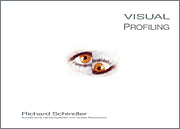 |
Schindler,
Richard: Visual Profiling (deutsch/englisch) Jena: IKS Garamond, 2001 zahlreiche farbige Abb. ISBN 3-934601-33-2 Beim Verlag bestellen. |
|
Titelseite Richard Schindler: Visual Profiling. Künstlerischer Handlungsfelder in Unternehmen, Institutionen und anderswo. Jena 2001 |
|
|
In Austtellungen und Kunstaufträgen für öffentliche Bauwerke entwickelte Richard Schindler seine besondere rekonstruktive Arbeitsweise. Sie ist geeignet bildkünstlerische Strukturanalysen durchzuführen und damit eine Grundlage für weitere künstlerische Arbeit zu schaffen. Das Buch Visual Profiling stellt grundsätzliche Überlegungen vor und bietet Beispiele aus verschiedenen kulturellen Bereichen. Vgl: Institut für Visual Resources Development & Visual Profiling Der Begriff Visual Profiling wurde analog zu Crime Profiling gebildet. Crime Profiling ist ein Fachbegriff der gerichtlichen Praxis. Er bezeichnet die spezifische kriminalistische Ermittlungstätigkeit der sogenannten Profiler, die anhand einer gegebenen Spurenlage ein Täterprofil erstellen. Entsprechend erstellt ein Visual Profiler ein bildnerisches Strukturprofil anhand des visuell Wahrnehmbaren: in Unternehmen, Institutionen und anderswo. Visual Profiling erlaubt eine bildnerische Rekonstruktion der Sinnstruktur vorhandner Bilder: z.B. künstlerischer Bilder (im Rahmen von Forschung und Lehre), der eigenen künstlerischen Produktion (im Sinne der Selbstvergewisserung), der Architektur (für Kunst im öffentlichen Raum) oder der Erscheinung eines Unternehmens (zum Zweck der Beratung). Visual Profiling bedeutet eine Ausweitung traditioneller künstlerischer Handlungsfelder und zielt auch auf eine neue Möglichkeit der Kooperation von Kunst und Wirtschaft. Visual Profiling ist der Versuch die Frage zu beantworten, wie, auf der Grundlage autonomer künstlerischer Arbeit, ein nachvollziehbarer Beitrag der Kunst zu anderen kultrellen Bereichen geleistet werden kann.
Visual Profiling Ordering from Garamond. The more products become similar to one another as a result of high-tech standards in production, the greater the importance of their differences for the market, differences which can be singled out exclusively on a symbolic level. The same applies to corporations: their market success is essentially dependent upon whether and how internal and external corporate communication succeeds. But in the visualizations of brands and corporate conceptions, an unintended and possibly counterproductive structure of meaning materializes as well. The so-called brand and corporate images are indeed images. They can be analyzed in art terms and plausibly reconstructed. These matters are the topic of the book. Artistic experience teaches us that the visible surface of things is their whole truth and conceals nothing. On the basis of various examples, the author Richard Schindler argues the plausibility of the thesis that, beyond intended and unintended visual messages, artifacts have a founding image-based meaning. The text advances reasons for why this meaning is not perceived. Richard Schindler call the art-based procedure of laying bare
visually realized structures of meaning "visual profiling" (VP). Visual
profiling means an expansion of traditional fields of artistic action, and it
aims at a new possibility in the cooperation of art and economics – beyond
sponsoring or art collection on the part of corporations. VP is a crucial
condition for an efficient and responsible development of visual resources. |
|